2. 西安建筑科技大学冶金工程学院, 西安 710055;
3. 陕西省冶金工程技术研究中心, 西安 710055
2. School of Metallurgical Engineering, Xi'an University of Architecture and Technology, Xi'an 710055, China;
3. Research Centre on Metallurgical Engineering and Technology of Shaanxi Province, Xi'an 710055, China
煤炭作为世界上最重要的资源,占一次能源结构的27%[1],煤炭仍然是我国的主要能源。随着煤炭资源的大量开采,煤矸石作为煤炭开采以及洗煤过程中的低碳高灰分固体产物,约占煤炭总量的10%[2],成为最大的工业废渣之一。开展煤矸石的综合利用,已成为关系到煤炭工业可持续发展的关键问题之一[3]。煤矸石内部含有大量SiO2和Al2O3[4],通过改性可以具有一定的比表面积,从而作为一种廉价的吸附材料[5, 6]。
煤矸石内部炭含量较少,通过外部引入炭源可以更好的制备活性炭多孔硅复合材料[7]。浒苔粉作为一种藻类生物质,内部主要含有脂质、碳水化合物和蛋白质[8, 9],藻类生物质在经过炭化后拥有更多的比表面积[10],因此在煤矸石中加入浒苔粉可以大大提高复合材料的吸附性能。
煤矸石改性制备吸附材料方面,张给禄等[11]和Ye[12]等用碱改性煤矸石,改性后煤矸石对磷酸盐最大吸附容量可达11.796 mg·g-1。Li等[13]利用煤矸石作为硅源和铝源,添加竹子作为碳源,采用水热法制备了沸石-活性炭复合材料,对铜离子吸附量达到104.9 mg·g-1,对罗丹明B的吸附量达到83.34 mg·g-1。Wang等[14]通过高温煅烧制备生物炭,在此基础上加入煤矸石共同煅烧,在700 ℃时制备了煤矸石生物炭的复合材料,复合材料吸附水中的磷酸盐并且可以将其作为缓释肥料。刘肖遥等[15]利用碱浸法从煤矸石中提取硅液,并用提取的硅液吸附CO2。但是煤矸石作为吸附材料对SO2气体的吸附研究较少。
本研究以煤矸石为基底材料,浒苔粉为额外碳源,通过碱熔、酸浸制备活性炭多孔硅复合材料。研究活化剂浓度、活化温度、活化时间对复合材料吸附性能的影响,并通过氮气吸附、扫描电镜(SEM)、傅里叶红外光谱(FTIR)、X射线衍射分析(XRD)和能谱仪(EDS)对复合材料的结构及SO2吸附性能进行了分析。
1 实验部分 1.1 材料煤矸石取自山西省保德县,浒苔取自连云港赣榆区海洋,煤矸石经过鄂式破碎、球磨、烘干后过200目筛备用,浒苔烘干磨碎过200目筛备用。煤矸石和浒苔粉的元素分析如表 1所示,煤矸石X射线荧光光谱分析如表 2所示。
| 样品 | 元素分析/% | |||
| Cd | Hd | Nd | Sd | |
| 煤矸石 | 13.011 | 1.311 | 0.007 | 2.822 |
| 浒苔粉 | 29.052 | 4.423 | 1.534 | 3.841 |
| 物质 | 质量分数/% |
| SiO2 | 54.04 |
| Al2O3 | 31.72 |
| Fe2O3 | 4.87 |
| K2O | 1.46 |
| CaO | 1.13 |
| P2O5 | 0.12 |
| SO3 | 3.86 |
| MgO | 1.40 |
| 其他 | 1.40 |
将煤矸石和浒苔粉质量各5 g与氢氧化钠溶液以1∶3进行浸渍,在80 ℃下烘干24 h。然后放入管式炉,通入氮气保护,采用单因素实验法,一步炭化活化法制备复合材料。依次考察氢氧化钠浓度(10%、15%、20%、25%和30%,质量分数,下同)、活化温度(700、750、800、850和900 ℃)、活化时间(20、40、60、80和100 min)对复合材料吸附性能的影响。经过碱活化剂高温改性后酸浸1 h,然后用去离子水洗至中性烘干备用,其工艺流程见图 1。

|
| 图 1 复合材料制备流程图 Fig.1 Flowchart of composite material preparation |
| |
碘吸附值采用国标GB/T 7702.7-2008《煤质颗粒活性炭试验方法——碘吸附值的测定》的方法进行测定。采用GeminiSEM 500型扫描电子显微镜对复合材料的表面微观形貌和孔结构特性进行分析。采用Nicolet iS50型傅里叶变换红外光谱仪分析复合材料表面官能团以及键能结构。采用D/max-2600/PC型X射线衍射仪分析复合材料物相的转变。采用JW-BK132F型比表面积及孔径分析仪对复合材料比表面积和孔隙结构进行分析。
1.4 脱硫性能采用固定床反应器进行脱硫实验。按照《HJ/T 56—2000固定污染源排气中二氧化硫的测定-碘量法》[16]计算实验过程中出口烟气的SO2浓度,用硫容来评估复合材料的脱硫性能。硫容由式(1)计算。
| $q_{\mathrm{SO}_2}=\frac{Q_{\mathrm{L}} M_{\mathrm{SO}_2} \int_0^t\left(c_{\mathrm{in}}-c_{\text {out }}\right) \mathrm{d} t \times 10^{-3}}{m V_{\mathrm{m}}}$ | (1) |
式(1)中:qSO2为硫容,mg·g-1;QL为总气体量,L;MSO2为SO2的相对分子质量;cin为进口处SO2浓度,10-6;cout为出口处SO2浓度,10-6;m为吸附剂质量,g;Vm为气体摩尔体积,22.4 L·mol-1。
2 结果与讨论 2.1 制备条件对复合材料吸附性能的影响 2.1.1 活化剂浓度对复合材料吸附性能的影响在活化温度800 ℃、活化时间60 min、原料质量比1∶1的条件下,考察NaOH浸渍浓度对复合材料吸附性能的影响,结果如图 2所示。
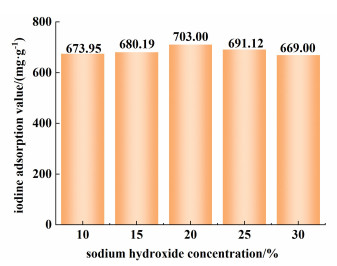
|
| 图 2 NaOH浸渍浓度对复合材料碘吸附值的影响 Fig.2 Effect of NaOH impregnation concentration on iodine adsorption value of composites |
| |
由图 2可以看出,随着NaOH浸渍浓度的升高,复合材料碘吸附值呈现先升高后下降的趋势。NaOH在高温条件下与煤矸石中的SiO2和Al2O3反应生成NaAlSiO4,然后经过HCl酸洗生成无定形二氧化硅和钠盐,大大提升了孔隙结构。另外,NaOH提高了热解反应速率[17],加快了非炭成分去除。在高温下碱活化剂会和炭原子发生还原反应生成钠蒸汽[18],这可以改变芳香层周围碳原子的电子云分布,从而产生更多的反应活性位点[19],但当NaOH浓度较大时,吸附性能降低,这可能是由于碱蚀刻导致微孔结构变成大孔结构[20]。因此选择NaOH浸渍浓度为20%。
2.1.2 活化温度对复合材料吸附性能的影响在NaOH浓度为20%、活化时间为60 min、原料比为1∶1的条件下,考察活化温度对复合材料吸附性能的影响,结果如图 3所示。
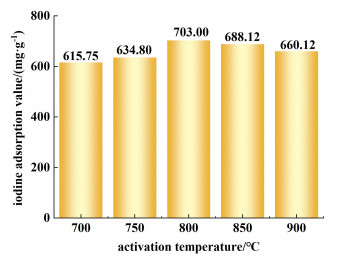
|
| 图 3 活化温度对复合材料碘吸附值的影响 Fig.3 Effect of activation temperature on iodine adsorption value of composites |
| |
由图 3可以看出,随着活化温度的升高,复合材料碘吸附值先升高后下降,在800 ℃达到峰值。煤矸石在750 ℃开始分解内部高岭石,在800 ℃开始脱羟基分解生成活性高的偏高岭石,部分组成由晶相变成非晶相,NaOH与部分偏高岭石反应生成更多孔隙结构[21],并且在温度开始升高时内部炭材料上的孔结构会迅速生成。当温度继续升高,孔径会进一步变大,微孔将变为中大孔,并且在高温的作用下会产生莫来石这种不易分解的成分[22],使得复合材料吸附性能降低,因此选择活化温度为800 ℃。
2.1.3 活化时间对复合材料吸附性能的影响在NaOH浓度为20%、活化温度为800 ℃、原料质量比为1∶1的条件下,考察活化时间对复合材料吸附性能的影响,结果如图 4所示。
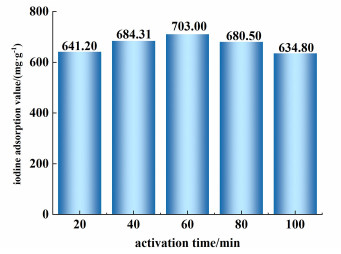
|
| 图 4 活化时间对复合材料碘吸附值的影响 Fig.4 Effect of activation time on iodine adsorption value of composites |
| |
由图 4可以看出,在60 min前复合材料的碘吸附值增加,这是由于随着反应地进行,NaOH在内部开始反应,与炭元素和煤矸石内部的SiO2和Al2O3开始反应,生成孔隙结构以及物相的转变,复合材料吸附性能增加。但在60 min后复合材料的碘吸附值呈现下降趋势,说明活化时间过长时微孔结构慢慢转化成大孔,影响孔隙结构,从而影响碘吸附值[23]。因此选择60 min为适宜的活化时间。
通过考察活化剂浓度、活化温度、活化时间对复合材料吸附性能的影响,得出在本实验所考虑的实验条件下,制备复合材料的较适宜工艺条件是:NaOH浸渍浓度为20%,活化温度为800 ℃,活化时间为60 min。所制得的复合材料碘吸附值为703 mg·g-1。
2.2 复合材料表征 2.2.1 XRD分析采用XRD对煤矸石和浒苔粉、活化后的复合材料和酸洗后的复合材料进行物相组成分析,结果见图 5。
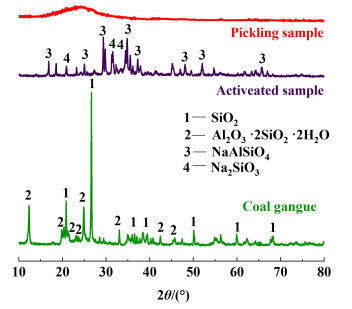
|
| 图 5 煤矸石浒苔粉、高温活化后的复合材料和酸洗后的复合材料的XRD衍射图谱 Fig.5 XRD patterns of coal gangue enteromorpha powder, composite material after high temperature activation and composite material after pickling |
| |
由图 5可以看出,煤矸石主要成分是石英(SiO2)、高岭石(Al2O3·2SiO2·2H2O)等,经过NaOH浸渍,高温活化后内部物相组成发生明显变化,石英和高岭石的衍射峰消失转化为NaAlSiO4和Na2SiO3形式存在,具体反应式见(2)和(3),这表示在氢氧化钠和高温活化下,煤矸石的内部物相发生了变化[24]。高温活化后的复合材料再经HCl酸洗处理后反应式见(4),NaAlSiO4和Na2SiO3与HCl反应,其中NaCl和AlCl3以离子形式存在于溶液,酸洗后复合材料鼓包峰出现在15°~30°左右,这表明硅元素占比增高,硅元素以无定形二氧化硅的形式存在,形成活性炭和多孔硅的复合材料。
| $\begin{gathered} \mathrm{Al}_2 \mathrm{O}_3 \cdot 2 \mathrm{SiO}_2 \cdot 2 \mathrm{H}_2 \mathrm{O}(\text{高岭石})+2 \mathrm{NaOH} \rightarrow \\ 2 \mathrm{NaAlSiO}_4+3 \mathrm{H}_2 \mathrm{O} \end{gathered}$ | (2) |
| $\mathrm{SiO}_2(\text{石英})+2 \mathrm{NaOH} \rightarrow \mathrm{Na}_2 \mathrm{SiO}_3+\mathrm{H}_2 \mathrm{O}$ | (3) |
| $\mathrm{NaAlSiO}_4+4 \mathrm{HCl} \rightarrow \mathrm{SiO}_2+\mathrm{NaCl}+\mathrm{AlCl}_3+2 \mathrm{H}_2 \mathrm{O}$ | (4) |
| $\mathrm{Na}_2 \mathrm{SiO}_3+2 \mathrm{HCl} \rightarrow \mathrm{SiO}_2+2 \mathrm{NaCl}+\mathrm{H}_2 \mathrm{O}$ | (5) |
采用FT-IR对煤矸石和浒苔粉、高温活化后的复合材料和酸洗后的复合材料进行分析,结果见图 6。
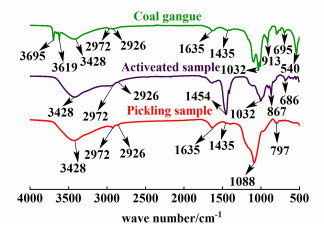
|
| 图 6 煤矸石浒苔粉、高温活化后的复合材料和酸洗后的复合材料的红外光谱图 Fig.6 Infrared spectra of coal gangue enteromorpha powder, composite material after high temperature activation and composite material after pickling |
| |
由图 6可以看出,煤矸石在没有经过处理时在3 695和3 619 cm-1处有高岭石衍射峰,这与XRD图谱中显示的特征峰对应。在经过高温以及碱活化后煤矸石内部高岭石衍射峰完全消失,高温活化后的复合材料出现1 454、1 032、867和686 cm-1特征峰,这是由于在高温活化后生成Na2SiO3和NaAlSiO4有关。在经过酸洗后Na2SiO3和NaAlSiO4的特征峰消失,1 088 cm-1处的Si—O—Si反对称伸缩振动吸收峰强度变强,和797 cm-1处Si—OH弯曲振动吸收峰出现,表明产品中出现大量多孔硅[25],在2 972、2 926和1 435 cm-1处的衍射峰为活性炭衍射峰,与XRD图谱一致,这说明制备出的是活性炭多孔硅复合材料。
2.2.3 SEM-EDS分析采用SEM-EDS对复合材料的微观形貌以及炭、硅元素分布情况进行分析,结果见图 7。
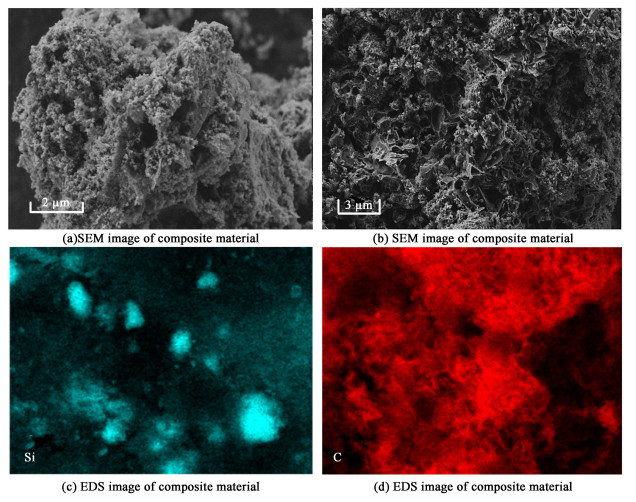
|
| 图 7 复合材料的SEM-EDS (a)~(b)复合材料SEM图像; (c)~(d)复合材料EDS图像 Fig.7 SEM-EDS diagram of composite materials. (a), (b) SEM image of composite material; (c), (d) EDS image of composite material |
| |
由图 7(a)可以看出,复合材料为不规则状颗粒,表面存在着大小不一的孔,从图 7(b)可以看出表面的孔呈层状结构堆积[26]。由图 7(c)和图 7(d)可以看出复合材料表面含有丰富的炭、硅元素。
2.2.4 BET分析采用氮气吸附仪对复合材料的氮气吸-脱附曲线及孔径进行分析,如图 8所示。
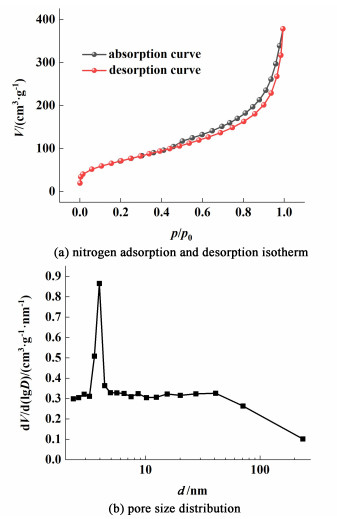
|
| 图 8 复合材料的氮气吸脱附等温线和孔径分布图 Fig.8 Nitrogen adsorption and desorption isotherm and pore size distribution of the composite |
| |
由图 8(a)可以看出,复合材料的N2气吸附脱附曲线为Ⅳ型等温线,开始时吸附量随相对压力的增大急剧上升,吸附速率很快,到一定的分压下出现一接近水平状的吸附平台。随后吸附量随着相对压力的增大继续增加,但上升趋势缓慢,导致吸附平台并非呈水平状,而是有一定的斜率,并伴有H3回滞环,H3回滞环的出现表明复合材料吸附为多层吸附[27]。
由图 8(b)可以看出,活性炭的孔径分布比较集中,大部分为大于2 nm的中孔,主要集中在4.5 nm左右,BET分析表明产品表面分布层状结构堆积成的微孔和介孔,孔径小于10 nm的介孔占比41.07%,比表面积可达246.90 m2·g-1,平均孔径5.885 nm,总孔容0.14 cm3·g-1。与吸附等温线具有明显的吸附滞后环吻合。复合材料比表面积SBET、总孔容V及平均孔径d如表 3所示。
| 样品 | SBET/(m2·g-1) | V/(cm3·g-1) | d/nm |
| 复合材料 | 246.90 | 0.14 | 5.885 |
对较适宜条件下制备的复合材料进行脱硫性能研究,气体入口体积分数为1 400×10-6的二氧化硫气体,固定床反应器高度50 cm,直径为25 mm,复合材料填装高度为75 mm,总供气量为500 mL·min-1,氮气为平衡气。穿透曲线如图 9所示。
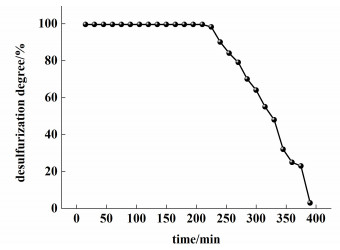
|
| 图 9 复合材料的穿透曲线 Fig.9 Penetration curve of composite material |
| |
由图 9可以看出,复合材料240 min之前脱硫率都高达98%,240 min后脱硫率逐渐降低,这是由于复合材料表面的活性位点随着脱硫时间的增加而被占据,导致脱硫率慢慢下降直至饱和。计算得出穿透硫容为76.5 mg·g-1,说明复合材料具有良好的吸附性能。
为了更直观的观察复合材料表面对SO2的吸附效果,对脱硫后的复合材料进行EDS表征,如图 10所示,S元素均匀的分布在复合材料的表面[28],说明了复合材料具有良好的脱硫性能。
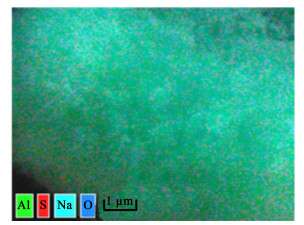
|
| 图 10 复合材料脱硫后的EDS图像 Fig.10 EDS image of composite material after desulfurization |
| |
(1) 复合材料的吸附性能随着NaOH浸渍浓度、活化温度的升高,活化时间的延长,碘吸附值呈现先升高后下降的趋势。通过单因素实验法优化了复合材料的制备工艺,复合材料碘吸附性能达到703 mg·g-1,比表面积可达246.90 m2·g-1。
(2) 煤矸石中SiO2主要以高岭石和石英的形式存在,在额外增加炭源的情况下对其进行高温化学活化,改变了煤矸石内部炭和Si元素的活性,经过碱熔-酸浸过程后最终Si元素以无定形二氧化硅存在于复合材料,制备出活性炭多孔硅的复合材料。
(3) 复合材料在240 min前对SO2气体的脱除率高达98%,穿透时间为390 min,穿透硫容为76.5 mg·g-1。在脱硫过程中S元素均匀分布在复合材料上,复合材料具有良好的脱硫性能。
| [1] |
ZHANG Y, ZHANG Y, LI Y, et al. Study on the characteristics of coal spontaneous combustion during the development and decaying processes[J]. Process Safety and Environmental Protection, 2020, 138: 9-17. DOI:10.1016/j.psep.2020.02.038 |
| [2] |
LI J, WANG J. Comprehensive utilization and environmental risks of coal gangue: A review[J]. Journal of Cleaner Production, 2019, 239: 117946. DOI:10.1016/j.jclepro.2019.117946 |
| [3] |
HAO Y, GUO X, YAO X, et al. Using Chinese coal gangue as an ecological aggregate and its modification: A review[J]. Materials, 2022, 15(13): 4495. DOI:10.3390/ma15134495 |
| [4] |
金会心, 吴复忠, 朱明燕, 等. 贵州六盘水煤矸石的矿物特性[J]. 过程工程学报, 2014, 14(1): 151-156. JIN Huixin, WU Fuzhong, ZHU Mingyan, et al. Mineral characteristics of coal gangue from Liupanshui in Guizhou Province[J]. The Chinese Journal of Process Engineering, 2014, 14(1): 151-156. (in Chinese) |
| [5] |
李宏伟, 燕可洲, 文朝璐, 等. 煤矸石制备活性炭-介孔硅复合材料及其过程物相转变[J]. 煤炭科学技术, 2023, 51(9): 310-319. LI Hongwei, YAN Kezhou, WEN Zhaolu, et al. Preparation of activated carbon-mesoporous silica composites from coal gangue and phase transformation during its preparation[J]. Coal Science and Technology, 2023, 51(9): 310-319. (in Chinese) |
| [6] |
刘雨春, 苏伟, 孙艳, 等. 玉米芯基氮掺杂活性炭的制备及吸附性能研究[J]. 化学工业与工程, 2023, 40(5): 135-143. LIU Yuchun, SU Wei, SUN Yan, et al. Preparation of nitrogen-doped activated carbon derived from corncob and adsorption property[J]. Chemical Industry and Engineering, 2023, 40(5): 135-143. DOI:10.13353/j.issn.1004.9533.20210859 (in Chinese) |
| [7] |
ZENG J, WEI L, GUO X. Bio-inspired high-performance solid-state supercapacitors with the electrolyte, separator, binder and electrodes entirely from kelp[J]. Journal of Materials Chemistry A, 2017, 5(48): 25282-25292. DOI:10.1039/C7TA08095F |
| [8] |
GAO S, ZHAO G, GUO L, et al. Utilization of coal gangue as coarse aggregates in structural concrete[J]. Construction and Building Materials, 2021, 268: 121212. DOI:10.1016/j.conbuildmat.2020.121212 |
| [9] |
姚伯雨, 刘宇泽, 赵铭浩, 等. 蓝藻基水热炭的制备及其对六价铬的吸附研究[J]. 环境保护与循环经济, 2019, 39(11): 19-23, 50. YAO BoYu, LIU Yuze, ZHAO Minghao, et al. Preparation of cyanobacteria-based hydrothermal carbon and its adsorption of hexavalent chromium[J]. Environmental Protection and Circular Economy, 2019, 39(11): 19-23, 50. DOI:10.3969/j.issn.1674-1021.2019.11.006 (in Chinese) |
| [10] |
赵晓玲, 曾丹, 林黄刚, 等. 生物质多孔碳的制备、掺杂及应用[J]. 化工新型材料, 2023, 51(7): 49-54. Zhao Xiaoling, Zeng Dan, Lin Huanggang, et al. Preparation, doping and application of porous carbon from biomass[J]. New Chemical Materials, 2023, 51(7): 49-54. (in Chinese) |
| [11] |
张给禄, 张梦瑶, 刘义青, 等. 锌改性煤矸石的制备及其对废水中磷酸盐的吸附去除[J]. 土木与环境工程学报, 2022, 44(3): 141-149. Zhang Zhilu, Zhang Mengyao, Liu Yiqing, et al. Preparation of Zn-modified coal gangue and its adsorption and removal of phosphate from wastewater[J]. Journal of Civil and Environmental Engineering, 2022, 44(3): 141-149. (in Chinese) |
| [12] |
YE T, MIN X, LI X, et al. Improved holding and releasing capacities of coal gangue toward phosphate through alkali-activation[J]. Chemosphere, 2022, 287(Pt 4): 132382. |
| [13] |
LI H, ZHENG F, WANG J, et al. Facile preparation of zeolite-activated carbon composite from coal gangue with enhanced adsorption performance[J]. Chemical Engineering Journal, 2020, 390: 124513. DOI:10.1016/j.cej.2020.124513 |
| [14] |
WANG B, MA Y, LEE X, et al. Environmental-friendly coal gangue-biochar composites reclaiming phosphate from water as a slow-release fertilizer[J]. The Science of the Total Environment, 2021, 758: 143664. DOI:10.1016/j.scitotenv.2020.143664 |
| [15] |
刘肖遥. 煤矸石基多孔硅材料的制备、改性及吸附二氧化碳性能的研究[D]. 呼和浩特: 内蒙古工业大学, 2017 LIU Xiaoyao. The preparation and modification of coal gangue based porous silica materials and itsapplication of CO2 adsorption[D]. Huhehaote: Inner Mongolia University of Technology, 2017(in Chinese) |
| [16] |
中华人民共和国生态环境部. 固定污染源排气中二氧化硫的测定碘量法: HJ/T 56—2000[S]. 北京: 中国环境科学出版社, 2004 Ministry of Ecology and Environment of the People's Republic of China. Determination of sulphur dioxide from exhausted gas of stationary source Iodine titration method: HJ/T 56—2000[S]. Beijing: China Environmental Science Press, 2004(in Chinese) |
| [17] |
ZHANG Y, LING T. Reactivity activation of waste coal gangue and its impact on the properties of cement-based materials-A review[J]. Construction and Building Materials, 2020, 234: 117424. DOI:10.1016/j.conbuildmat.2019.117424 |
| [18] |
张凤娥, 张坤. 改性煤矸石吸附废水中磷酸盐的研究[J]. 安全与环境学报, 2021, 21(6): 2774-2780. ZHANG Feng'e, ZHANG Kun. Study on modified coal gangue adsorbing phosphate in wastewater[J]. Journal of Safety and Environment, 2021, 21(6): 2774-2780. (in Chinese) |
| [19] |
吴俊峰, 余海静, 王现丽. 改性煤矸石吸附处理印染废水的试验研究[J]. 矿业安全与环保, 2010, 37(6): 27-28, 6. WU Junfeng, YU Haijing, WANG Xianli. Experimental study on adsorption of modified coal gangue for treatment of printing and dyeing wastewater[J]. Safety and Environmental Protection of Mining Industry, 2010, 37(6): 27-28, 6. DOI:10.3969/j.issn.1008-4495.2010.06.008 (in Chinese) |
| [20] |
MOGHADAM M J, AJALLOEIAN R, HAJIANNIA A. Preparation and application of alkali-activated materials based on waste glass and coal gangue: A review[J]. Construction and Building Materials, 2019, 221: 84-98. DOI:10.1016/j.conbuildmat.2019.06.071 |
| [21] |
ZHOU L, ZHOU H, HU Y, et al. Adsorption removal of cationic dyes from aqueous solutions using ceramic adsorbents prepared from industrial waste coal gangue[J]. Journal of Environmental Management, 2019, 234: 245-252. |
| [22] |
LIU F, XIE M, YU G, et al. Study on calcination catalysis and the desilication mechanism for coal gangue[J]. ACS Sustainable Chemistry & Engineering, 2021, 9(30): 10318-10325. |
| [23] |
MICHALAK I, BAŚ'LADYŃSKA S, MOKRZYCKI J, et al. Biochar from a freshwater macroalga as a potential biosorbent for wastewater treatment[J]. Water, 2019, 11(7): 1390. DOI:10.3390/w11071390 |
| [24] |
郭文超, 朱晓波, 张治国, 等. 煤矸石焙烧活化-酸浸提取氧化铝的实验研究[J]. 煤炭转化, 2023, 46(6): 80-89. GUO Wenchao, ZHU Xiaobo, ZHANG Zhiguo, et al. Experimental study on extraction of alumina from coal gangue by roasting activation-acid leaching[J]. Coal Conversion, 2023, 46(6): 80-89. (in Chinese) |
| [25] |
LIU X. Low-carbon utilization of coal gangue under the carbon neutralization strategy: A short review[J]. Journal of Material Cycles and Waste Management, 2023, 25(4): 1978-1987. DOI:10.1007/s10163-023-01712-w |
| [26] |
WU Q, ZHANG G, GAO M, et al. N-doped porous carbon from different nitrogen sources for high-performance supercapacitors and CO2 adsorption[J]. Journal of Alloys and Compounds, 2019, 786: 826-838. DOI:10.1016/j.jallcom.2019.02.052 |
| [27] |
MA X, LI L, CHEN R, et al. Doping of alkali metals in carbon frameworks for enhancing CO2 capture: A theoretical study[J]. Fuel, 2019, 236: 942-948. DOI:10.1016/j.fuel.2018.08.166 |
| [28] |
SHEN F, LIU J, WU D, et al. Design of O2/SO2 dual-doped porous carbon as superior sorbent for elemental mercury removal from flue gas[J]. Journal of Hazardous Materials, 2019, 366: 321-328. DOI:10.1016/j.jhazmat.2018.12.007 |
 2024, Vol. 41
2024, Vol. 41





